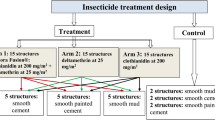Abstract
Bendiocarb 80WP, applied at 1 and 2 g/m2, was compared with BHC 30WP, applied at 0.5 g/m2 of gamma isomer, for the control of the important Chagas’ disease vector Triatoma infestans, in Brazil. The insecticides performance was evaluated in groups of about 20 heavily infested, mud- or adobe-walled houses selected on the basis of pre-spray sample data. These houses, together with a check group of untreated, infested houses, were sampled for the presence of T. infestans pre-spray and at 1, 3, 5, 7 and 9 months post-treatment employing a systematic search technique with the aid of a flushing-out agent. This method was found to detect infestations in from 71 to 95% of the samples taken in groups of infested, untreated houses. Treatment with bendiocarb 80WP at 2 g/m2 resulted in the elimination of T. infestans from 40 to 50% of the infested houses, whereas BHC 30WP at 0.5 g/m2 reduced the number of infested houses by 70–80%. In the houses where the bugs were not eliminated the populations were markedly reduced in size by the insecticides, but became reestablished by 5 months post-spraying. Detailed analysis of the field trial sample data together with the results of a simple laboratory experiment suggest that although bendiocarb WP powder may be intrinsically more toxic to triatomines than BHC WP, it is less persistent when applied in houses largely constructed of mud.
Similar content being viewed by others
References
Brener Z. and Andrade Z. (1979) Trypanosoma cruzi e doenca de Chaças. Guanabara Koogan, Rio de Janeiro, 463 pp.
Castro Filho J. and Silveira A. C. (1979) Distribuição da doença de Chagas no Brasil. Rev. Bras. Malar. Doenç. trop. 31, 85–98.
Coosemans N. H. and Sales S. (1978) Stage IV evaluation of three insecticides—OMS-1, OMS-1394 and OMS-1998 against anopheline mosquitos; residual effects of two insecticides—OMS-1821 and OMS-1856. WHO/VBC Unpublished document series No. 78.687.
Dias E. and Zeledon R. (1955) Infestação domiciliária em grau extremo por Triatoma infeslans. Mem. Inst. Osw. Cruz, 53, 473–486.
Eshgy N., Janbarkhsh B. and Motabar M. (1979) Experimental hut trials for the evaluation of bendiocarb (Ficam W) against Anopheles stephensi, Khesht district, Ka-zeroun, Southern Iran, 1977. Mosquito News 39, 126–129.
Eshghy N., Motabar M. and Janbakhsh B. (1980) Village scale trial of bendiocarb (Ficam W) for the control of Anopheles stephensi in Mamasani, Southern Iran, 1978. Mosquito News 40, 514–519.
Goose J. (1980) The use of bendiocarb to control fleas. In: Fleas (Edited by Traub R. and Starcke H.), pp. 315–320. A. A. Balkema, Rotterdam.
Hervy J. P. and Sales S. (1979) Stage IV evaluation of imagocides—OMS-43, OMS-1331 and OMS-1394—at the Soumousso experimental station, Upper Volta, during 1978. WHO IVBC unpublished document series No. 79.727.
Lemon R. W. (1971) 2,2-Dimethyl-l,3-benzodioxol-4-yl methyl carbabamate, a new broad spectrum experimental insecticide. Proc. 6th Br. Insectic. Fungic. Conf. 570–576.
Lewis T., Cherbett, J. M., Haines I., and Mathias P. L. (1976) The crazy and (Anoplolepis longipes (Jerd.) (Hyme-noptera, Formicidae) in Seychelles, and its chemical control. Bull. ent. Res. 66, 97–111.
Mariconi F. A. M., Zamith A. P. L., Araújo R. L., Oliveira Filho A. M. and Pinchin R. (1980) Inseticidas Tomo 3, e seu emprego no combate às pragas. Livraria Nobel, Sao Paulo, 246 pp.
Martin H. and Worthing C. R. (Eds) (1977) Pesticide Manual, 5th edn, British Crop Protection Council, Droitwich, England, 593 pp.
Nelson M. J. and Colmenares P. (1979) Insecticide susceptibility of vectors of Chagas’disease in Venezuela. WHO/VBC unpublished document series No. 79.736.
O’Brien R. D. (1976) Acetylcholinesterase and its inhibition. In: Insecticide Biochemistry and Physiology (Edited by Wilkinson C. F.), 768 pp. Plenum Press, New York.
Pinchin R., Oliveira Filho A. M., Ayala C. A. C. and Gilbert B. (1978) Slow-release insecticides for triatomine control: preliminary field trials. Rev. Bras. Malar. Doenc. trop. 30, 57–63.
Pinchin R., Oliveira Filho A. M. and Gilbert B. (1979) Field trials of slow-release formulations of chlorpyrifos and malathion for the control of Chagas’disease vectors. Rev. Bras. Malar. Doenc. trop. 31, 19–27.
Pinchin R., Oliveira Filho A. M., Fanara D. M. and Gilbert B. (1980a) A preliminary field trial of decamethrin (OMS 1998) for the control of Triatoma infestans. WHO/VBC unpublished document series No. 80.797.
Pinchin R., Oliveira Filho A. M. and Gilbert B. (1980b) Field trial of permethrin for the control of Triatoma infestans. WHO/VBC unpublished document series No. 80.779.
Pinchin R., Fanara D. M., Castleton C. W. and Oliveira Filho A. M. (1981a) A comparative study of domestic survey techniques for the Chagas’disease vector, Triatoma infestans. Insect Sci. Applic. 3, 79–84.
Pinchin R., Fanara D. M. and Oliveira Filho A. M. (1981b) A village-scale field trial of pirimiphos-methyl (OMS 1424) wettable powder and slow-release formulations in comparison with HCH for the control of Triatoma infestans in Brazil. WHO jVBC unpublished document series, (in press).
Rabinovich J. E., Leal J. A. and Piñero D. F. (1979) Domiciliary biting frequency and blood injestion of the Chagas’disease vector, Rhodnius prolixus Stähl (Hemiptera: Reduviidae), in Venezuela. Trans. R. Soc. trop. Med. Hyg. 73, 272–283.
Rettich F. (1978) Contact toxicity of some or-ganophosphates, carbamates and pyrethroids to adults of Anopheles messeae. Acta Ent. Bohemoslov. 75, 362–368.
Rettich F. (1980) Residual toxicity of wall-sprayed organophosphates, carbamates and pyrethroids to mosquito Culex pipiens molestus Forskal. J. Hyg. Epidem. Microbiol. Immun. 24, 110–117.
Rishikesh N., Clarke J. L., Mathis H. L., King J. S. and Pearson J. A. (1978) Stage IV evaluation of five insecticides—OMS-43, OMS-1394, OMS-1825, OMS-1856 and OMS-1998—on anopheline mosquitos in village huts near Kaduna, Nigeria. WHO/VBC unpublished document series No. 78.701.
Schofield C. J. (1979) The bahaviour of triatominae (Hemiptera: Reduviidae): a review. Bull. ent. Res. 69, 363–379.
Author information
Authors and Affiliations
Rights and permissions
About this article
Cite this article
Pinchin, R., Fanara, D.M. & Oliveira Filho, A.M. A Village-Scale Field Trial of Bendiocarb (Oms 1394) for the Control of the Chagas’disease Vector Triatoma Infestans in Brazil. Int J Trop Insect Sci 5, 121–126 (1984). https://doi.org/10.1017/S1742758400001776
Received:
Revised:
Published:
Issue Date:
DOI: https://doi.org/10.1017/S1742758400001776




